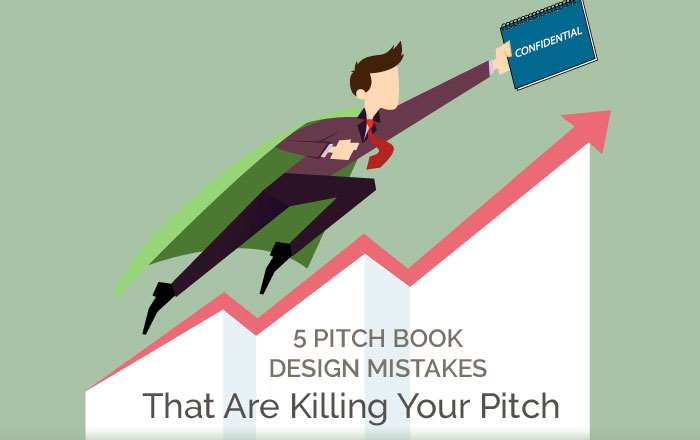For investment bankers and mergers & acquisition advisors, the sauce is in the pitch book.
As the single most important tool in your marketing kit, it’s how you show companies that you understand the culture of the business being pitched and illustrate unique insight into the marketplace.
Most bankers and advisors rely on pitch books for new business, but if you don’t present your points in an organized way that is easy to follow, you could very easily lose people’s interest before they get to the thing they really care about: “show me the money”.
To help you avoid this and keep contacts engaged, here’s how to fix some of the most common mistakes with pitch book design.
Presenting vs. Reading
First off, your pitch book serves two purposes. You present it and then you leave the printed book with your contact to look over. You probably also send it as an email attachment.
There’s a fundamental difference between presenting and reading, and the difference is you. During your presentation, you can elaborate and explain key talking points. Taking cues from your audience, you can get their feedback, answer any questions they have, and guide the discussion down an appropriate path.
Reading a deck is entirely different. Whether it’s on paper or on a screen, people have to understand your pitch book as clearly as when you presented. That means that those key talking points need to be in there, and they need to jump out at people.
What can you do? Try to find the middle ground where your pitch book is easy to digest without requiring additional narration. You may be tempted to cram as much text as possible on each page, but please resist that urge.
More information does not equal clarity. In fact, writing long-winded paragraphs can be an indication that you’re circling around the focal point of your content. And if you’re struggling with it, you can be sure that your contacts will be too.
Step back and read each page, this time from the eyes of your audience. Do you get the main topics at a glance? If not, start editing.
Find as few words as possible to communicate your points, and get to them as quickly as possible. People just don’t have time to cuddle up with your pitch book for a great read. They need to get it right away.
Many pitch books follow the same pattern: they show a simple chart on one page and then 6 long paragraphs of text on the next. This makes your message hard to grasp. Instead, spread out your content so that each page is equally balanced. Displaying a chart on one page doesn’t mean you can’t include some text. On the other hand, 6 paragraphs is just over the top. Rather than overwhelm readers, split that page into two or cut down on the copy.
Which brings us to the second mistake,
Lacking Focus and Clarity
Place an isolated chart with some data and labels on a white page and readers will immediately know what to focus on. The same can’t be said of a page full of copy, especially when your content is competing with the header and footer of your presentation.
It’s simply not good practice to burden people with a dense, overstuffed deck.
Readers will skim your pitch book presentation for keywords and titles. Their eyes will flit across the page looking for something to grab on to. Don’t make them work harder than they have to in order to find it.
What can you do? Structure your message in a simple way by placing one idea per page to help streamline and focus the flow of the pitch book. Including too much unnecessary material will only result in losing people’s attention and potentially the deal.
Be consistent with font sizes and the use of white or “negative” space on each page. Develop a hierarchy of styles for titles, headings, paragraphs and bullets and only deviate from it if you absolutely have to.
In some cases it makes sense to have more text. You may have a sequence of connected topics that need to be presented together. Just be sure that you’re consistent with font sizes and colors. Try to avoid using one font size on a dense page and another larger font size on the next page. You don’t want to interrupt the flow as readers’ eyes adjust to the abrupt change.
Poor Design
You don’t drive a Toyota or even a BMW, you drive a Ferrari. And that’s what company owners expect to see you drive.
So why would you show up with a pitch book that’s the equivalent of a Toyota?
Your presentation is an opportunity to leave a lasting impression on contacts and differentiate your firm from competitors. A pitch book without a cohesive color palette and strategic positioning of elements is like wearing a crumpled old shirt to work. It’s just not effective.
Having a professional design is the key to communicating your message in a way that has real impact.
What can you do? Make sure your deck stands out on a boardroom table and clearly establishes you as an authority in your space. Everything from the cover to the paper stock should differentiate your brand. Using a heavier weight or semi-transparent cover will help make a strong impression.
Create a style guide that defines colors, font sizes, chart treatment and image specifications. This way you can can walk readers through your pitch book presentation and lead them to a desired outcome.
I’ve seen too many pitch books with colors that are hard on the eyes. Consider how color affects moods and emotion, and choose a palette that supports your corporate identity and expresses your brand voice. Primary colors should match your logo and secondary colors should be used for charts, tables and other graphics.
Use a hierarchy of font sizes and styles for titles and headers, subheads, bullets, copyright line and disclosures. This will help readers focus on what’s most important.
And don’t think you have to use every inch of space on the page. Strategic use of white or “negative” space is a powerful way to direct readers to important keywords and highlights.
If your goal is to position your brand as an authority and leader in the marketplace, it’s crucial that every touch point provides the same experience. Make sure your design is co-branded and consistent across all of your marketing materials: pitch book, website, overview brochure, performance reports, email, and so on.
Whatever you do, don’t shout it out. A subtle, refined design will undoubtedly have a great impact on your pitch book’s success.
No Visual Creativity
How can you convince owners of your forward-thinking solutions if you hand them a pitch book presentation that’s dated and lackluster?
Today more than ever, visual is where it’s at. Nobody has the time to sift through globs of text. If you don’t break up text with graphics, people will glaze over and miss important messaging.
What can you do? Use more graphics and less text. People expect to see eye-catching charts, tables, icons and other graphic elements to help them understand what they’re reading. Using visuals in your pitch book is a great way to capture their attention and help them digest the information.
Find ways to transform data into interesting donut charts, process charts, timelines and so on. Create one style for each type of chart in your presentation so that readers can distinguish them easily. Choose different (but complimentary) colors for bar charts, line charts, pie charts, and tables.
Why not create a sidebar with an interesting graphic highlighting key points? Even if they skim the other text on the page they’ll be sure to make note of the most important points.
Don’t stop there. Challenge yourself to think visually and outside of the box with every page. Use infographs and icons to communicate important your data and allow readers to make visual connections with your messaging.
Once you let your creative juices go, you will find more and more ways to graphically interpret information so that even dense pages of text can be visually transformed without sacrificing quality.
Key Takeaway
When it comes to pitch books, the message is in the medium. In order to differentiate your firm and cut through the clutter, a pitch book must stand out on a board room table and take less than 30 minutes to digest. Use the tips here to make sure your book leaves an immediate and lasting impression with contacts. Most importantly, key data and highlights need to jump off the page and grab the reader’s attention. The way to do that is to define and implement style guidelines for titles, headings, text, graphics and charts. If you need help with the design of your pitch book, please contact us.

